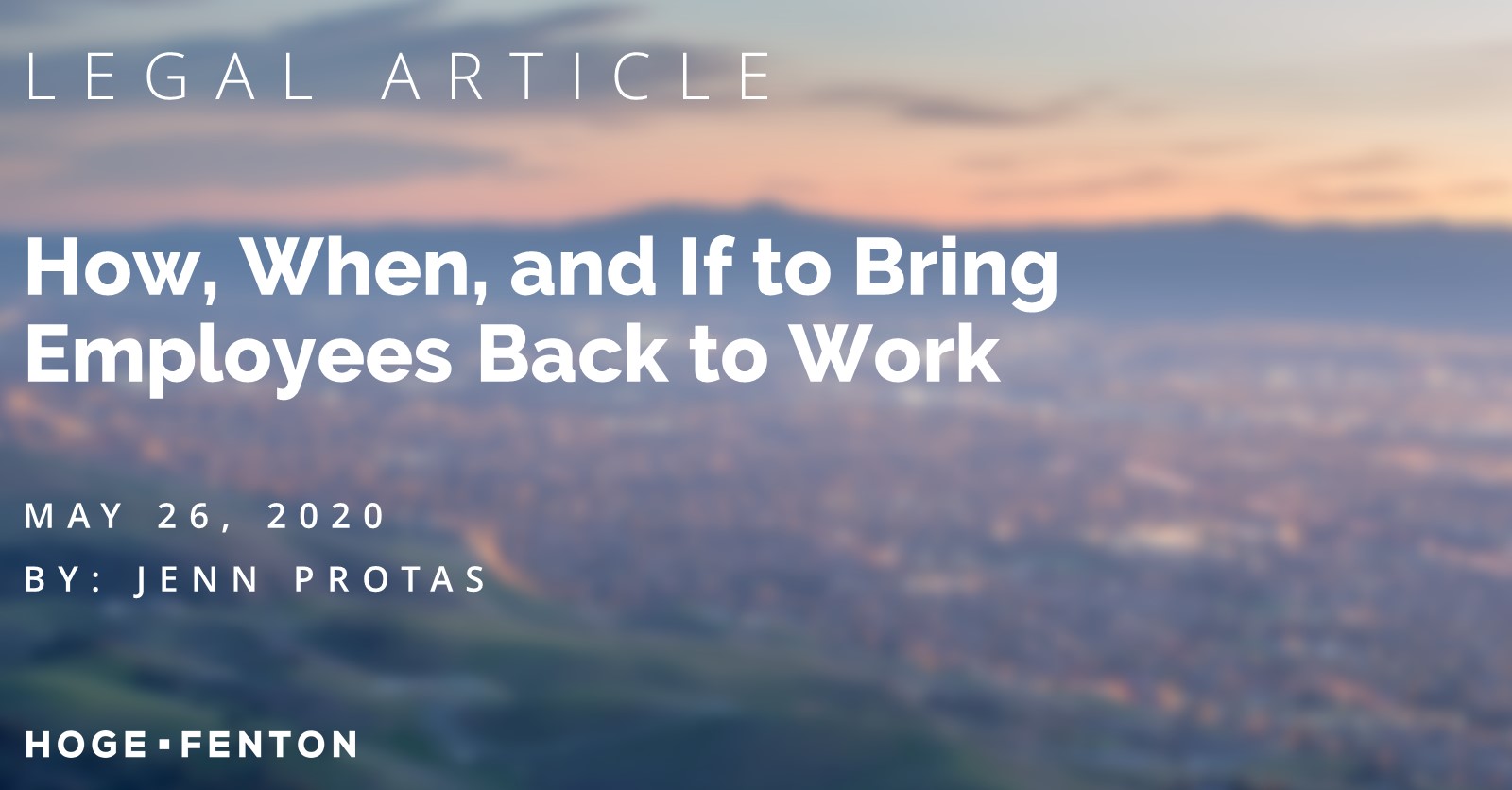How, When, and If to Bring Employees Back to Work
By Hoge Fenton | 05.26.2020 | Client Alerts

This paper is provided as an educational service. It is an overview only, and should not be construed as legal advice or advice to take any specific action. If you have questions regarding any of the content contained in this presentation, we recommend you seek the assistance of a knowledgeable legal professional.
California employers’ concerns regarding the coronavirus pandemic have come in waves:
- initial concerns over health and safety
- the impact of county and state shelter-in-place orders
- whether each business was an essential business
- whether and how to furlough or lay off employees
- compliance with the FFCRA
- whether businesses qualify for a PPP loan and how to maximize forgiveness
Employers are now shifting their focus to how, when, and if to bring employees back to work.
In considering these issues, employers should be mindful to protect themselves against lawsuits, including what we anticipate will be a flood of class action lawsuits by employees.
Working From Home
Where feasible, employers will likely have some employees continue to work from home, if only to enable social distancing at the worksite.
Managing a remote workforce comes with its challenges, regardless of the circumstances. When the shelter-in-place orders went into effect, employers moved quickly to shift to working from home. Most employers did not have time to consider the risks and to put safeguards in place. However, as remote working becomes an ongoing and potentially long-term option, employers should ask remote employees to enter into a Work From Home Agreement, which can address issues such as:
- protecting the security of your company’s confidential property and information,
- managing employee availability and work hours
- designating a worksite to mitigate workers’ compensation exposure
- other relevant issues
Recommendation:
Employers should ask remote employees to enter into a Work From Home Agreement.
Working from home does not eliminate employers’ wage and hour obligations to provide timely, compliant meal periods, adequate rest breaks, and pay for all hours worked. It may be even more tempting for employees to not record their time. For instance, an employee could easily check their email off-hours and not record their time because they are trying to work while also caring for and homeschooling their children. Wage and hour claims are frequently the source of class actions and Private Attorney General Act claims.
Recommendation:
To the extent possible, employers should communicate clearly with non-exempt employees regarding timekeeping practices, meal periods and rest breaks, and off the clock work. Employers should also continue to monitor employee time records to manage these issues.
Employers should also determine whether any municipal ordinances in cities where remote employees live (and therefore work) require that you modify your sick leave accruals and balances, minimum wages, or grant employees additional leaves of absence or benefits. San Francisco, for example, has a Family Friendly Workplace Ordinance, which gives eligible employees the right to request a flexible or predictable work arrangement to assist with care for elderly parents, persons with serious health conditions, and children under the age of 18.
Recommendation:
- Create a list of cities where employees live.
- Check the cities’ municipal ordinances to determine if modifications are necessary to your policies, including, for example, sick leave accruals and balances, minimum wages, or leaves of absence or benefits.
Employers also have an obligation to reimburse employees for all necessary and reasonable business expenses. If employees are working from home for the employer’s benefit, employees may have a right to reimbursement of all sorts of expenses, including their home internet costs, increased utility fees, and possibly even light bulbs, batteries, and toilet paper!
Recommendation:
- Determine whether employees are working from home for your company’s benefit.
- For those employees working from home for your company’s benefit, contact an employment attorney to determine what expenses may be reimbursable.
If employers do have to separate employees who are remote, employers should prepare in advance to ensure they can timely pay final wages. California requires final wages be paid within 24 hours of the separation (essentially, the same day) when the employer terminates the employment relationship. That’s more challenging when you cannot simply hand your employee a check and walk them out the door.
Returning to Work
The most pressing concern for employers who are working to bring employees back to work once state and county orders permit is do follow all guidance and requirements for social distancing protocols (Bay Area counties, for instance, require employers to post a “Social Distancing Protocol” at each facility substantially in the form of Appendix A to the Shelter-in-Place Order), provide proper protective equipment, ramp up disinfecting practices, screen employees for symptoms, and otherwise provide for the health and safety of their employees (and customers, if permitted by county and state orders). The state has issued guidance by industry. California Governor Gavin Newsom signed an executive order creating a rebuttable presumption that employees who contract COVID-19 are entitled to workers’ compensation benefits if the employee tested positive for or was diagnosed with COVID-19 within 14 days after a day (on or after March 19, 2020) that the employee performed labor or services at the employee’s place of employment (and not the employee’s home or residence) at the employer’s direction.
Employers who are screening employees’ symptoms and temperatures should be careful to avoid retaining and disclosing medical information so as not to run afoul of privacy rights. Taking employee temperatures is, in “normal” times, an impermissible medical examination, but the EEOC has permitted taking employee temperatures during the current pandemic.
Even with all the precautions, some employees may be unwilling to return to work. While ordinarily employers have the right to discipline and/or terminate employees who refuse to work, employers may not do so if employees have a good faith believe that there is a real danger of death or serious injury and meet various conditions, including asking the employer to eliminate the danger. Even if such fear is not credible, employees may have a mental disability, such as anxiety, which employers may need to accommodate.
Recommendation:
- Follow all guidance and requirements for social distancing protocols (Bay Area counties, for instance, require employers to post a “Social Distancing Protocol” at each facility substantially in the form of Appendix A to the Shelter-in-Place Order).
- Provide proper protective equipment.
- Ramp up disinfecting practices.
- Create a procedure to screen employees for symptoms that preserves employees’ privacy rights
- Otherwise provide for the health and safety of your employees (and customers, if permitted by county and state orders).
- Review the state’s guidance by industry for additional clarification for your industry.
- Consider your response to employees want to continue to work from home and not return to the workplace.
Other Potential Legal Landmines
Employers face other threats of litigation:
- Harassment, Discrimination, and Retaliation. Reports of mistreatment or harassment of Asian-Americans is on the rise and may lead to an increase in harassment and discrimination claims on the basis of race. Further, layoffs, furloughs, reductions in pay, and hiring/re-hiring employees give rise to risks of harassment, discrimination, and retaliation claims where decisions have a disparate impact on employees of a protected class or where employees are treated differently on the basis of protected class (e.g., treating high-risk employees, such as those with disabilities or older employees, differently than other employees).
- WARN/CalWARN. Furloughs and layoffs may also trigger WARN and CalWARN, statutes that require employers provide advance notice to employees of terminations.
- Exempt Employees. As employers shuffle duties around to address having fewer people working, employers may jeopardize exempt employees’ classifications if they are no longer performing exempt tasks at least 50% of their time worked. Similarly, reducing exempt employee pay below the minimum salary threshold will result in a loss of the exemption.
- FFCRA and other leave statutes. Employers with fewer than 500 employees also have new obligations with respect to paid sick leave and expanded family and medical leave requirements under the Families First Coronavirus Response Act (FFCRA). And some jurisdictions have imposed additional temporary obligations on employers, even if they are not subject to the FFCRA.
Phew! With all that and more to consider, even the most well-intentioned employers can trip up, especially as they struggle to navigate this new territory we’re all facing. While you cannot eliminate all risk, relying on your employment law attorneys will help you mitigate risk as you move forward.
Please reach out to our advisors below if you need more guidance or visit Hoge Fenton’s COVID-19 Resources page.
 |
 |
|
Shareholder, Attorney
+1.408.947.2435
|
Shareholder, Chair
+1.408.947.2456
|
This information is provided as an educational service by Hoge Fenton for clients and friends of the firm. This communique is an overview only, and should not be construed as legal advice or advice to take any specific action. Please be sure to consult a knowledgeable professional with assistance with your particular legal issue. © 2020 Hoge Fenton










